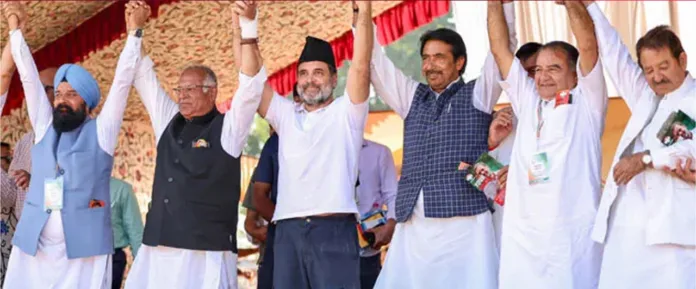Over 2.5 million voters head to the polls as key political figures, including Omar Abdullah and Ravinder Raina, contest across 26 constituencies
As Jammu and Kashmir enter the second phase of its assembly elections, over 2.5 million eligible voters prepare to cast their votes today. This phase encompasses 26 constituencies, with 11 in Jammu and 15 in the Kashmir region. The elections promise to be significant, showcasing a competitive field of candidates that could reshape the political landscape of the Union Territory.
The electoral contest features prominent figures, each bringing their political weight and influence to the forefront. Omar Abdullah, the former Chief Minister and vice president of the National Conference, campaigns from two constituencies—Budgam and Ganderbal. Abdullah’s family has deep roots in the region, having held these seats for generations. In Budgam, he faces seven rivals, including the People’s Democratic Party’s Aga Syed Muntazir Mehdi and Awami National Conference’s Aga Syed Ahmad Moosvi.
Ravinder Raina, president of the Bharatiya Janata Party’s J&K unit, seeks re-election from the Nowshera seat in Rajouri district. Raina faces stiff competition from Surinder Choudhary, a former BJP colleague now running under the National Conference banner. Choudhary enjoys backing from the Congress party, which is joining forces with the National Conference in this election.
Altaf Bukhari, the leader of the Apni Party and the wealthiest candidate in this phase, competes from the Channapora seat in Srinagar. With assets exceeding ₹165 crore, Bukhari aims to secure his position against a robust field, including PDP’s Mohammed Iqbal Trumboo and National Conference’s Mushtaq Guroo.
Another key figure is Tariq Hameed Karra, the J&K Pradesh Congress Committee chief. He runs for the Central Shalteng seat in Srinagar, facing tough opponents such as PDP’s Abdul Qayum Bhat and Awami National Conference’s Riyaz Ahmad Mir. Karra, a former Lok Sabha MP, switched allegiance from the PDP to Congress in 2017, citing dissatisfaction with the BJP-PDP alliance.
Notably, Sarjan Ahmad Wagay, a jailed cleric known as Sarjan Barkati, has filed nomination papers for two constituencies—Ganderbal and Beerwah. Barkati gained notoriety during the 2016 protests following the death of Hizbul Mujahideen terrorist Burhan Wani. His current legal battles, including charges under the Unlawful Activities (Prevention) Act (UAPA), add a complex layer to his candidacy.
The first phase of polling witnessed a voter turnout of 61.38%, reflecting a strong public interest in these elections. The results from this phase, combined with the high-profile candidates in play, make this election a pivotal moment for Jammu and Kashmir.
Analysis
Political Perspective
The Jammu and Kashmir assembly elections have profound implications for the political dynamics of the region. With key players like Omar Abdullah and Ravinder Raina vying for power, the elections could signal a shift in party allegiances and voter sentiments. Abdullah’s presence represents a continuity of the traditional political framework in Kashmir, while Raina’s campaign emphasizes the BJP’s commitment to national integration and governance reforms. The electoral outcome may redefine alliances among local parties and impact governance in the Union Territory.
Social Perspective
The ongoing elections reflect significant societal debates within Jammu and Kashmir. The participation of diverse candidates, including those with varying ideological backgrounds, highlights a vibrant democratic process. However, it also brings forth discussions around issues such as regional identity, governance, and public service delivery. Voter engagement levels can signify the public’s perception of political accountability and transparency in governance.
Racial Perspective
The election process underscores the complexities of identity politics in Jammu and Kashmir. The region’s demographics are diverse, with various ethnic and religious groups. Candidates’ ability to connect with these communities will significantly influence electoral outcomes. The representation of different communities in political discourse can either bridge gaps or widen divides, emphasizing the need for inclusivity in policymaking.
Gender Perspective
Gender representation in the Jammu and Kashmir assembly elections remains a critical issue. Although women constitute a significant portion of the electorate, their representation in candidacies and leadership roles is limited. Encouraging female candidates to participate in politics can lead to more comprehensive discussions around women’s rights, safety, and empowerment, influencing legislative priorities.
Economic Perspective
Economic factors play a crucial role in shaping electoral outcomes in Jammu and Kashmir. The region has faced economic challenges, exacerbated by political instability. Candidates must address issues like employment, infrastructure development, and trade to resonate with voters. The elections present an opportunity for parties to articulate their economic agendas and showcase their plans for sustainable growth and development.
In conclusion, the Jammu and Kashmir assembly elections stand at the intersection of political aspirations, societal dynamics, and economic realities. As the second phase of polling unfolds, the outcomes will likely influence not only the immediate political landscape but also the broader socio-economic fabric of the Union Territory.
